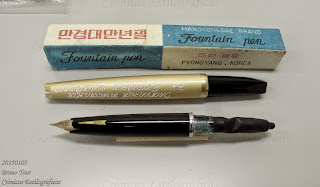
1. General impression. Introduction. (8/10)
This is a pocket pen. Its short barrel and long cap says so, but it also seems a long pocket pen as well. It is also a luxury pen—the cap is made of silver, and the nib, of white 18 K gold.
This pen, I guess, dates back to the 1970s, the heyday of pocket pens. A time when the three major pen companies in Japan made luxury products in small containers.
2. Appearance. (7/10)
Silver and black are the colors of this pen. And despite the silver cap, it does not look ostentatious. Might it be because of the natural patina of silver, in my opinion, this pen is more “shibui” than “hade”.
 Barrel and section are made of plastic, but the overall impression is of good quality. The clip, in black plastic, seems to be the less attractive detail on this pen. Cheap is the word for the clip.
Barrel and section are made of plastic, but the overall impression is of good quality. The clip, in black plastic, seems to be the less attractive detail on this pen. Cheap is the word for the clip.3. Design, size, weight. (6.5/10)
As it was already mentioned, this is a pocket pen. The main feature of this particular one is the sterling silver cap that makes it heavier than most of its size. For instance, a Platinum pocket pen of similar dimensions weights only 11 grams versus the 18 grams of this one with silver cap.
But this silver cap accounts for more than 60% of the total weight of the pen. This alone would make this pen quite unbalanced when posted for writing. However, this unbalance is far from extreme. The cap reaching relatively low on the pen, close to the nib, distributes the cap weight more evenly than in a regular sized pen.
These are the physical dimensions:
Diameter: 12 mm.
Length capped: 126 mm.
Length uncapped: 106 mm.
Length posted: 149 mm.
Weight: 18 g.
In comparison, a smaller Platinum pocket pen is just 116 mm long when capped and weights only 11 g.
The adjustment between cap and body —capped or posted— is excellent with no sign of becoming loose, or of wear despite its age.
4. Nib and writing performance. (7.5/10)
The nib is an 18 K white gold medium. Barely flexible. Very smooth. Excellent constant ink flow. This is a nib for those who favor smoothness and reliability over line variation and expressivity and character.

5. Filling system. (8/10)
Platinum used to manufacture short converters for their pocket pens, but that is not the case anymore. Therefore, Platinum pocket pen owners are bound to use Platinum proprietary cartridges.
 Nonetheless, there exist the possibility of modifying the current converter to use it in these short pens.
Nonetheless, there exist the possibility of modifying the current converter to use it in these short pens.There are also adapters to use international cartridges. I have no experience, but I understand they become very firmly attached to the pen, transforming it into an "international cartridge" pen to all effect. And there are aerometric converters that fit inside of these Platinum pocket pens in combination with this adapter.
6. Cost and value. (7.5/10)
Pocket pens are not expensive in the Japanese second hand market, and this pen is a good value given the nice appearance and the nib performance.
7. Conclusion. (44/60 = 74/100)
Nice looking pen although not the best pocket pen in the market. Scores high on looks and performance. Balance and size take points away.
Bruno Taut
(Inagi, June 30 2010)
[labels: Japón, Platinum]






























































